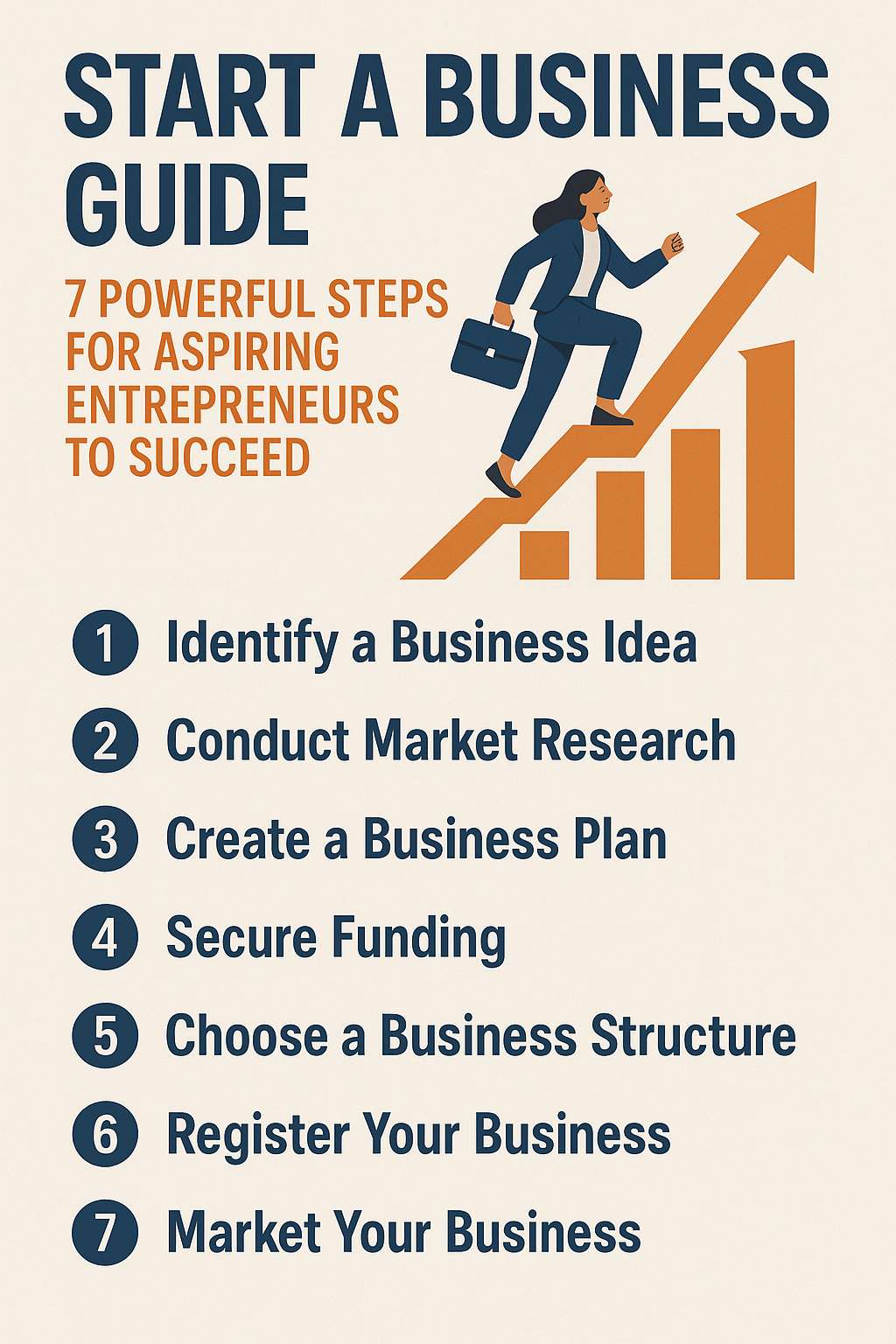
Introduction
Starting a business is an exciting yet challenging journey. Whether you dream of launching a tech startup, a local bakery, or an e-commerce empire, having a clear roadmap increases your chances of success.
This guide breaks down the 7 essential steps every aspiring entrepreneur should follow—from validating your idea to scaling your business. Let’s dive in!
Step 1: Find & Validate Your Business Idea
How to Identify a Profitable Business Idea
Solve a Problem: The best businesses address a pain point (e.g., Uber solved taxi hassles).
Follow Your Passion: If you love fitness, consider a gym, app, or wellness brand.
Research Trends: AI, sustainability, and remote work tools are booming industries.
Validate Your Idea Before Investing
Market Research: Check Google Trends, competitor demand, and industry reports.
Ask Potential Customers: Use surveys or social media polls to gauge interest.
Test with a MVP (Minimum Viable Product): Launch a simple version (e.g., a prototype or beta service) to test demand.
Step 2: Write a Solid Business Plan
A business plan keeps you focused and attracts investors. Key sections include:
Executive Summary – Brief overview of your business.
Market Analysis – Target audience, competitors, and industry trends.
Business Model – How you’ll make money (subscriptions, ads, product sales).
Marketing Strategy – Social media, SEO, influencer partnerships.
Financial Plan – Startup costs, revenue projections, and funding needs.
Pro Tip: Use free templates from SCORE or the SBA (Small Business Administration).
Step 3: Secure Funding for Your Business
Funding Options for Startups
Bootstrapping – Self-funding using savings or side hustles.
Loans & Grants – SBA loans, microloans, or government grants.
Investors – Angel investors, venture capitalists, or crowdfunding (Kickstarter).
Business Credit Cards – Useful for early expenses (but manage debt wisely).
Pitch Your Business Effectively
Prepare a one-page pitch deck highlighting:
The problem you solve
Your unique solution
Market opportunity
Revenue model
Step 4: Choose a Business Structure & Register
Common Business Structures
| Type | Pros | Cons | Best For |
|---|---|---|---|
| Sole Proprietorship | Easy setup, full control | Personal liability | Freelancers, small startups |
| LLC | Liability protection, flexible taxes | Slightly higher fees | Small to medium businesses |
| Corporation | Strong liability protection | Complex paperwork, double taxation | Scalable startups |
Legal Requirements
Register your business name (Do a trademark check!)
Get an EIN (Employer Identification Number) from the IRS
Obtain necessary licenses & permits (varies by industry)
Step 5: Build Your Brand & Online Presence
Create a Memorable Brand Identity
Business Name: Keep it simple, unique, and SEO-friendly.
Logo & Visuals: Use Canva or hire a designer for a professional look.
Brand Voice: Decide if your tone is friendly, professional, or bold.
Set Up Your Online Presence
Website: Use WordPress, Wix, or Shopify (for e-commerce).
Social Media: Focus on platforms where your audience hangs out (Instagram for visuals, LinkedIn for B2B).
SEO Basics: Optimize your site with keywords for better Google rankings.
Step 6: Launch & Market Your Business
Pre-Launch Strategies
Soft Launch: Offer early discounts to friends & family for feedback.
Email List: Collect emails via a landing page for future promotions.
Post-Launch Marketing
Content Marketing: Blog posts, YouTube videos, or podcasts.
Paid Ads: Facebook/Google ads for quick traffic.
Networking & Partnerships: Collaborate with influencers or local businesses.
Step 7: Scale & Optimize for Growth
Key Scaling Strategies
Automate Processes – Use tools like Zapier, QuickBooks, or CRM software.
Expand Product Line – Add complementary products/services.
Hire Smartly – Outsource tasks (virtual assistants, freelancers) before full-time hires.
Track Performance & Adapt
Monitor KPIs (Key Performance Indicators) like revenue, customer acquisition cost, and retention.
Get customer feedback and improve continuously.
Final Thoughts
Starting a business is a marathon, not a sprint. Follow these 7 steps, stay adaptable, and keep learning. Every successful entrepreneur started where you are now—take that first step today!
Need More Help? Check out resources like SCORE mentorship, Y Combinator Startup School, or local business incubators.
Would you like a downloadable checklist or a deeper dive into any step? Let me know! ?



